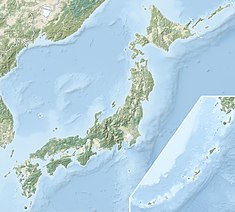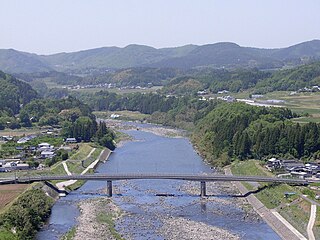
The Ōno River is a river that originates in Ōita Prefecture, Japan. After running through the southern and central portions of Ōita Prefecture, it runs through the eastern part of Kumamoto Prefecture and the northern part of Miyazaki Prefecture.
Hakusui was a village located in Aso District, Kumamoto Prefecture, Japan.
Kugino was a village located in Aso District, Kumamoto Prefecture, Japan.

Aso is a district located in Kumamoto Prefecture, Japan.

The Shinano River, known as the Chikuma River in its upper reaches, is the longest and widest river in Japan and the third largest by basin area. It is located in northeastern Honshu, rising in the Japanese Alps and flowing generally northeast through Nagano and Niigata Prefectures before emptying into the Sea of Japan.
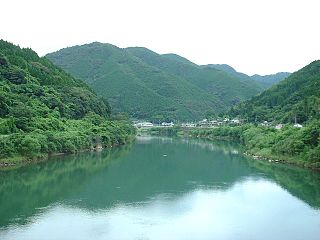
The Kuma River is a river in Kumamoto Prefecture, central Western part of Kyūshū, Japan. It is sometimes referred as Kumagawa River. It is the longest river in Kyushu, with the length of 115 km long and has a drainage area of 1,880 km2 (730 sq mi). The tidal flat of the Kuma River estuary is approximately 1000 hectares.
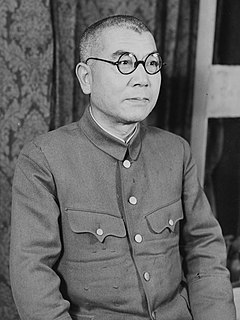
Akira Mutō was a general in the Imperial Japanese Army during World War II. He was convicted of war crimes and was executed by hanging. Mutō was implicated in both the Nanjing Massacre and the Manila massacre.

Minamiaso is a village in Aso District, Kumamoto Prefecture, Japan.
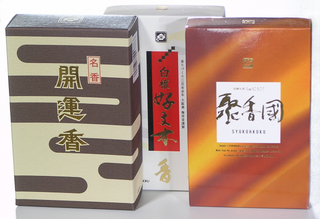
Baieidō is a Japanese incense company established in 1657, located in Sakai, Osaka Prefecture, It is one of the oldest traditional incense makers in Japan.

Malampuzha Dam is the second largest dam and reservoirs in Kerala, located near Palakkad, in the state of Kerala in South India, built post independence by the then Madras state. Situated in the scenic hills of the Western Ghats in the background it is a combination of a masonry dam with a length of 1,849 metres and an earthen dam with a length of 220 metres making it the longest dam in the state. The dam is 355 feet high and crosses the Malampuzha River, a tributary of Bharathappuzha, Kerala's second longest river. There is a network of two canal systems that serve the dam's reservoir of 42,090 hectares.

Matsue English Garden Mae Station is a railway station operated by Ichibata Electric Railway, located in Matsue, Shimane Prefecture, Japan.

Hakusui Dam (白水ダム) is a concrete gravity dam on the upper reaches of the Ōno River in Taketa, Ōita Prefecture, Japan. It was constructed in 1938, and is 86 m wide and 14 m tall.

The Takamori Line is a Japanese railway line in Kumamoto Prefecture, between Tateno Station, Minamiaso, and Takamori Station, Takamori. This is the only railway line Minamiaso Railway operates. As the company name suggests, the line traverses the south part of Mount Aso caldera.

Minamiaso Mizu-no-Umareru-Sato Hakusui-Kōgen Station, referred usually to as simply Hakusui-Kōgen Station, is a train station located in Minamiaso, Kumamoto, Japan. It is tied with Chojagahama Shiosai Hamanasu Koenmae Station for the longest train station name in Japan. It is also an ancient site of a well in the foothills of Japan's largest volcano, Mt. Aso.
Abe ryū or Abe-tate-ryū (安倍立流), also known as Abe-ryū Kendō, is a Japanese sword school founded by Abe Yoritō (安倍頼任) in the 17th century. Abe was a disciple of Taisha-ryū, an offshoot of Shinkage-ryū. He was considered a Kengō and instructor to the Akizuki-han in Chikuzen Province.

Chōjagahamashiosaihamanasukōenmae Station is a passenger railway station in the town of Kashima, Ibaraki Prefecture, Japan operated by the third sector Kashima Rinkai Railway. The station is tied with Minamiaso Mizu-no-Umareru-Sato Hakusui-Kōgen Station in Kumamoto Prefecture for the longest train station name in Japan, with 22 kana each. However, since the other station is closed due to the 2016 Kumamoto earthquakes, this station currently has the longest name in Japan.

The Gōnokawa River is a river that runs through Hiroshima and Shimane prefectures in Japan. It is the largest river in the Chūgoku region. It is also called the Gōgawa River and, in Hiroshima, the Enokawa River.
The Hanaguri Ide is a specially constructed 387-meter canal in Kikuyō, Kumamoto, Japan, which lets water flow into the downstream without depositing the mixed ash. The Aso area from which water flows is rich in such ash, volcanic in nature. This structure was credited to Katō Kiyomasa who had it constructed it in the early 1600s.
